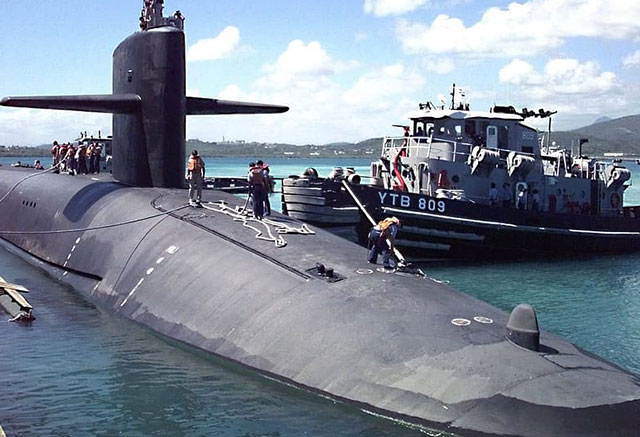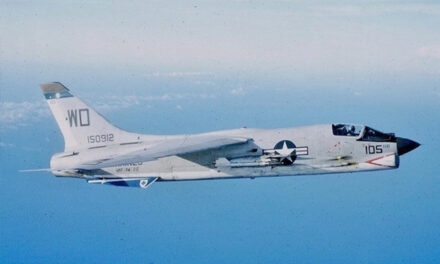OHIO Class submarine
The Ohio class of nuclear-powered submarines is the most powerful and most costly class of U.S Navy submarines. Ohio-class submarines are the largest submarines ever built for the U.S. Navy. They are the world’s third-largest submarines. Only two larger are the Russian Navy’s Soviet-designed 48,000-ton Typhoon class and 24,000-ton Borei class. United States Navy’s have a total of 18 Ohio class submarines, 14 ballistic missile submarines (SSBNs), and four cruise missile submarines (SSGNs).
The U.S. Navy give a contract to the Electric Boat Division of General Dynamics on 25 July 1974 for the construction and testing of one Trident submarine. The contract included an option for three additional submarines. The first hull was originally assigned hull number SSBN 711, but on 21 February 1974, it was reassigned hull number SSBN 1. In the following April, it was again changed to SSBN 726 to conform with the regular progression of submarine hull numbers.
The first eight ships in the OHIO Class (726-733) were launched and fitted with the Trident I C-4 (UGM 96A) ballistic missile system. All of the OHIO Class have twenty-four missile tubes located aft of the sail arranged in two rows of twelve. From the TENNESSEE (734) and beyond all have been fitted with the Trident II D-5 (UGM 133) ballistic missile system. All earlier ships are being retrofitted to Trident II, this was completed in mid-2008. Trident II can deliver significantly more payload than Trident I C-4 and more accurately. All 24 missiles can be launched in less than one minute.
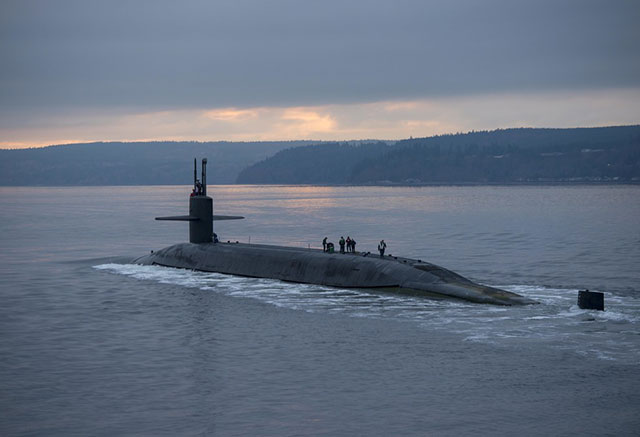
All 18 Ohio class submarines are commissioned between 1981 and 1997. In June 1992 Strategic Arms Reduction Treaty was agreed, START II to limit the number of strategic missile submarines to 14 from 2002. Rather than decommissioning these four submarines, the US Navy has converted them to conventionally armed nuclear-powered (SSGNs) submarines.

Line drawing of the Ohio class in its original SSBN configuration. (1) Sonar dome, (2) Main ballast tanks, (3) Computer room, (4) Integrated radio room, (5) Sonar room, (6) Command and control center, (7) Navigation center, (8) Missile control center, (9) Engine room, (10) Reactor compartment, (11) Auxiliary machinery room no. 2, (12) Crew’s berthing (13) Auxiliary machinery room no. 1, (14) Torpedo room, (15) Wardroom, (16) Chief petty officer quarters, (17) Missile compartment
Ohio class submarine specifications
Type: SSBN/SSGN (hull design SCB-304)
- Displacement: 16,764 tonnes (16,499 long tons) surfaced
- 18,750 tonnes (18,450 long tons) submerged
Length: 560 ft (170 m)
Beam: 42 ft (13 m)
Draft: 35.5 ft (10.8 m) maximum
- Propulsion: 1× S8G PWR nuclear reactor
- 2× geared turbines; 60,000 shp (45 MW) Fairbanks Morse auxiliary diesel
- 1× 325 hp (242 kW) auxiliary motor
- 1 shaft with seven-bladed screw
Speed:
- 12 knots (22 km/h; 14 mph) surfaced
- 20 knots (37 km/h; 23 mph) submerged (official)
- 25 knots (46 km/h; 29 mph) submerged (reported)
Range: Limited only by food supplies
Test depth: +800 ft (240 m)
Complement: 15 officers, 140 enlisted
Sensors and processing systems:
- BQQ-6 passive bow-mounted array (which includes BQS-13 fire control array)
- BQR-19 navigation
- TB-16 or BQR-23 towed array
- BQR-25 conformal array
Armament: 4 × 21 inch (533 mm) Mark 48 torpedo tubes (Forward Compartment 4th level)
General characteristics SSBN-726 to SSBN-733 from construction to refueling
Armament: 24 × Trident I C4 SLBM with up to 8 MIRVed 100 ktTNT W76 nuclear warheads each, range 4,000 nmi (7,400 km; 4,600 mi)
General characteristics SSBN-734 and subsequent hulls upon construction, SSBN-730 to SSBN-733 since refueling
Armament: 24 × Trident II D5 SLBM with up to 12 MIRVed W76 or W88 (475 ktTNT) nuclear warheads each, range 6,100 nmi (11,300 km; 7,000 mi)
General characteristics SSGN conversion
Armament: 22 tubes, each with 7 Tomahawk cruise missiles, totaling 154
Note: The SSGNs have the capacity to host up to 66 Navy Seal personnel at a time.
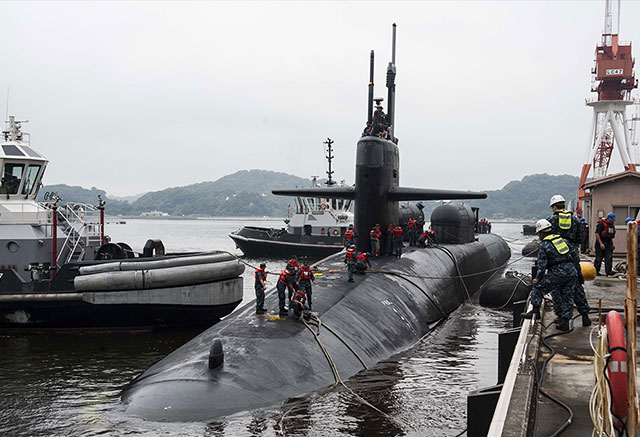
Ohio class submarine armament
Trident strategic ballistic missile
Ohio Class submarine is equipped with the Trident strategic ballistic missile from Lockheed Martin Missiles and Space. The Trident was built in two versions, Trident I (C4), which is being phased out, and the larger and longer-range Trident II (D5), which entered service in 1990. The submarines received the new D5LE missiles in 2013 under the D5 life extension program. The new missiles are expected to remain in service till the 2040s.
The US Navy describes the range as ‘greater than 7,360km’ but this could be up to 12,000km, depending on the payload mix. Missile guidance is provided by an inertial navigation system supported by stellar navigation.
Tomahawk missiles
Each SSGN capable of carrying up to 154 Tomahawk land-attack cruise missiles. The missiles are loaded in seven-shot Multiple-All-Up-Round Canisters (MACs) in up to 22 missile tubes. These missile tubes can also as storage for food, and other consumables, future payloads such as new types of missiles, unmanned aerial vehicles, and unmanned undersea vehicles.
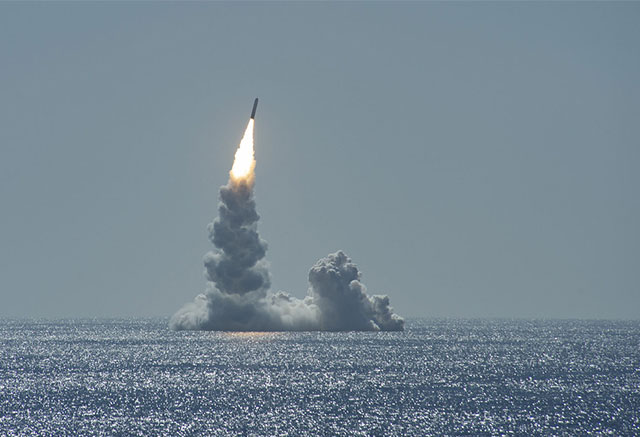
Ohio Class submarine torpedoes
The Ohio Class submarine is fitted with four 533mm torpedo tubes with an mk118 digital torpedo fire control system. The torpedoes are the Gould mk48. The MK-48 is designed to combat fast, deep-diving nuclear submarines and high-performance surface ships. It is carried by all US. Navy submarines. The mk48 is a heavyweight torpedo with a warhead of 290kg, which has been operational in the US Navy since 1972. The torpedo can be operated with or without wire guidance and the system has active and/or passive acoustic homing. The range is up to 50km at a speed of 40k. After launch, the torpedo carries out target search, acquisition, and attack procedures delivering to a depth of 3,000ft.
Ohio Class submarine countermeasures
The Ohio Class submarine is equipped with eight launchers for the mk2 torpedo decoy. Electronic warfare equipment is the WLR-10 threat warning system and the WLR-8(V) surveillance receiver from GTE of Massachusetts. The WLR-8(V) uses seven YIG-tuned and vector-tuned superheterodyne receivers to operate from 50MHz up to J-band. An acoustic interception and countermeasures system, AN/WLY-1 from Northrop Grumman, was developed to provide the submarine with an automatic response against torpedo attack.
Ohio class submarine sensors
BQQ-6 Passive Sonar
The eyes of a submerged submarine its sonar suite, either onboard or in a towed array. The passive sonar on the OHIO Class is the BQQ 6, which is comprised of the BQS 13 passive, spherical array sonar for fire control. The BQQ-6 Passive Sonar on the Ohio-class submarines is a long-range passive-only sonar.
AN/BQR-19
USA The AN/BQR-19, nicknamed Top Hat, is an active, short-range, rapid-scanning submarine sonar for collision avoidance, navigation, and other special applications, including upward-looking ice detection and mine detection.
TB-23 Thin Line Towed Array
Towed array technology has advanced rapidly with longer, multiline systems that have an increasing number of sensors. For submarine-based ASW, the thin-line TB-23 is routinely deployed. Experiments with adaptive beamforming on both arrays are demonstrating impressive results, especially for cluttered environments. Operational beamformers for towed arrays assume the array geometry to be straight and horizontal aft of the tow ship, whereas in reality there is always some deformation from this geometry. This is now measured by heading and depth sensors with varying degrees of success. The passive TB-23 array can only monitor gross deformations. A major limitation in current systems is that beamforming cannot be carried out when the ship is maneuvering, which can result in downtimes as great as 50 percent. Many existing Navy tow cable systems have single coaxial conductors, one to two kilometers in length, on which power, uplink data, and downlink data are multiplexed (e.g. SQR-19, TB-23, TB-29). These systems typically run at uplink data rates of less than 12 Mbit/s due to bandwidth limitations of the long coaxial cable.
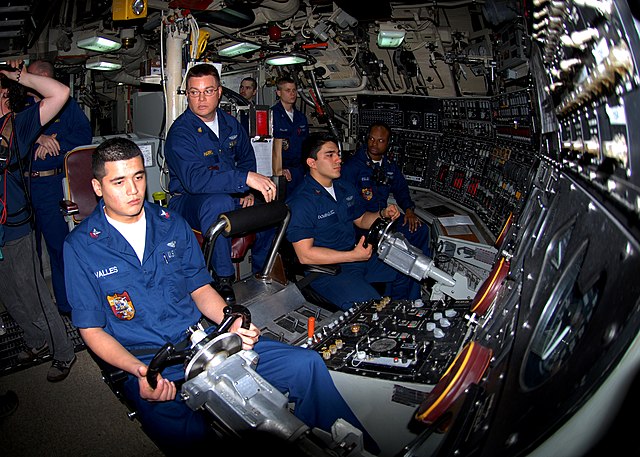
TB-16 Fat Line Towed Array
The TB-16 Fat Line Towed Array consists of a 1400 pound acoustic detector array, some 3.5 inches in diameter and 240 feet long, towed on a 2,400-foot long cable 0.37 inches in diameter weighing 450 pounds.
Radar BPS 15A
Surface radar surveillance is provided by the BPS 15A antenna that telescopes out of the sail (it is used only when the submarine is on the surface). The AN/BPS-15/16 series radars are submarine Class A X-Band systems providing a radar navigation capability in addition to performing routine surface detection. The AN/BPS-15/16 Radar Set provides all control, RF generation, transmission, reception, video signal processing, and interface functions necessary to supply processed radar video and trigger timing to a radar workstation.

